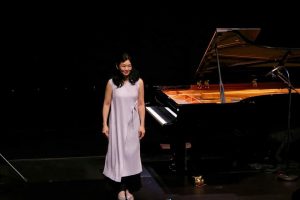À Paris, il y a juste sept mois jours pour jour, naissait une nouvelle salle de spectacle. « La Scala Paris »
J’avais eu le privilège de visiter ce lieu lorsqu’il était encore en ruines, mais où l’on sentait les vibrations si particulières d’un passé éclectique, puisqu’il abrita tour à tour music-hall, cinéma, films pornographiques et même une secte sud-américaine !
Après de longs travaux, le 11 octobre 2018, le moment de l’ouverture arriva.
Une vraie fête.
Les murs sentaient la peinture fraîche. Une énergie explosive partout, de grandes conversations dans les halls et les coulisses où tout le monde manifestait son enthousiasme,
Rodolphe Bruneau-Boulmier, qui a été chargé de la programmation musicale et s’est lancé dans l’aventure avec brio, nous invita, ma sœur et moi, à participer aux festivités inaugurales, dans leur partie musicale, en jouant une pièce du compositeur américain John Adams,
Tout l’espace de la Scala de Paris était rempli d’une véritable euphorie.
Aujourd’hui, sept mois après l’ouverture du théâtre, j’ai eu la joie d’y jouer à nouveau, et je me rends compte non seulement que l’acoustique de la salle s’est encore plus finement adaptée à l’instrument mais que les énergies qui m’accueillent ont changé:
Certes ce sont les mêmes murs bleu encre. Mais les énergies qui s’en dégagent sont encore plus puissantes tant ils ont vu, écouté de voix et de musiques diverses, vécu et absorbé d’émotions et de vibrations intenses, sur scène comme dans le public.
Des murs vivants. Des murs flexibles, Des murs qui sont en train de créer leur propre histoire.
J’ai eu l’occasion de jouer cette saison au Théâtre des Champs-Élysées qui est de 105 ans l’aîné de la Scala.
Peu après l’ouverture de la salle eut lieu la création du fameux Sacre de Printemps de Stravinsky.
Une grande prise de risque, j’imagine, et qui provoqua le grand scandale que l’on sait, avant que l’œuvre ne soit considérée, quelques années plus tard, comme un chef d’œuvre incontesté !
Les chaises ont volé dans la salle devant l’audace et l’incroyable innovation de ce langage inconnu.
Ces moments sont à jamais imprimés dans chacun des murs de cette salle.
Plus proche en âge de la Scala, la Philharmonie de Paris – autre lieu où j’ai eu l’occasion de jouer l’année dernier. Là aussi, les murs ont leur propre histoire, tout imprégnés qu’ils sont des merveilleux récitals et concerts symphoniques qu’ils accueillent.
Quant à La Scala de Paris, salle conviviale de par ses dimensions, et surtout véritable lieu de création – une sorte de laboratoire interactif bouillonnant de toutes disciplines artistiques -elle est née du rêve d’un couple intrépide et passionné au-delà de toute imagination, Mélanie et Frédéric Biessy. Et aujourd’hui, je l’ai ressenti très intensément, ses murs ont déjà une histoire singulière. Sept mois seulement après l’inauguration.
Comme ces privilégiés qui avaient assisté à la création du Sacre du printemps au Théâtre des Champs-Elysées, le public de La Scala de Paris dira aussi, dans quelques années, « J’y étais… » évoquant telle création ou telle découverte faite grâce à une programmation pointue.
C’est le beau destin de ce bijou de théâtre, de s’inscrire dans cette continuité de la création, avec audace, imagination, vision. Et de nous inviter nous enrichir de tous ces ferments de beauté.
Cheers à la création, à la géné rosité et au courage!
rosité et au courage!


 Yes, this is really me! These pictures were taken in Amsterdam, during a photo shoot for the cover of my new CD, which will be released in October.
Yes, this is really me! These pictures were taken in Amsterdam, during a photo shoot for the cover of my new CD, which will be released in October.
 And this event is supported by:
And this event is supported by:
 Chamber music was scheduled this time at the Tokyo Bunka Kaikan in Ueno, with the wonderful players of the Tokyo Metropolitan Symphony Orchestra. The program consisted of the French impressionist composers Debussy, Ravel and Chausson.
Chamber music was scheduled this time at the Tokyo Bunka Kaikan in Ueno, with the wonderful players of the Tokyo Metropolitan Symphony Orchestra. The program consisted of the French impressionist composers Debussy, Ravel and Chausson.


 Well that indeed was interesting in itself, but I was especially touched by an alignment of Hiroshige’s Ukiyoe that I saw in the next building. His concern toward even the smallest details, a mystery like a meditation through nature. And the hospitality and kindness of the Japanese — I thought I was being impressed many a time because of the very fact I was Japanese, but it came out the foreign people around me also were in admiration.
Well that indeed was interesting in itself, but I was especially touched by an alignment of Hiroshige’s Ukiyoe that I saw in the next building. His concern toward even the smallest details, a mystery like a meditation through nature. And the hospitality and kindness of the Japanese — I thought I was being impressed many a time because of the very fact I was Japanese, but it came out the foreign people around me also were in admiration. “Sinfonietta of Light” in the park of the Tuileries
“Sinfonietta of Light” in the park of the Tuileries

 外国育ちの姉と私に、母が「日本の伝統を伝えなくては」と、お正月にはいつもおせ ちとお雑煮を作ってくれます。
外国育ちの姉と私に、母が「日本の伝統を伝えなくては」と、お正月にはいつもおせ ちとお雑煮を作ってくれます。